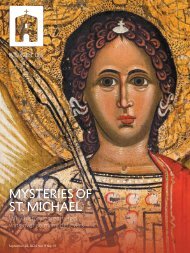Angelus News | August 2-9, 2019 | Vol. 4 No. 27
A nationwide trend pushing to remove tributes to certain historical figures of U.S. history has seized on a new, unlikely target: the bells lining California’s iconic El Camino Real. The reason? The belief that Spanish missionaries — among them St. Junípero Serra — were oppressors, captors, and even murderers of California’s first peoples. On Page 10, renowned historian Gregory Orfalea examines the most common critiques of the Spanish evangelization of California and makes the case for why the bells represent a legacy of love, not oppression.
A nationwide trend pushing to remove tributes to certain historical figures of U.S. history has seized on a new, unlikely target: the bells lining California’s iconic El Camino Real. The reason? The belief that Spanish missionaries — among them St. Junípero Serra — were oppressors, captors, and even murderers of California’s first peoples. On Page 10, renowned historian Gregory Orfalea examines the most common critiques of the Spanish evangelization of California and makes the case for why the bells represent a legacy of love, not oppression.
You also want an ePaper? Increase the reach of your titles
YUMPU automatically turns print PDFs into web optimized ePapers that Google loves.
makes clear that when it comes to<br />
resolving the quantum paradox, faith<br />
and science are not only compatible<br />
but need each other.<br />
DeLano was inspired to create “The<br />
End of Quantum Reality” after he<br />
encountered Smith’s writings. “What<br />
inspired me to share this story,” he<br />
told <strong>Angelus</strong> <strong>News</strong>, “was the recognition<br />
that I had encountered in Dr.<br />
Wolfgang Smith a profound genius, a<br />
man whose work is of centuries-spanning<br />
significance.”<br />
Impressive as an individual scholar<br />
might be, a film about quantum<br />
physics and its refutation runs the<br />
risk of being much too dense for a<br />
lay audience. Luckily, “The End of<br />
Quantum Reality” does an impressive<br />
job presenting complex principles in<br />
a straightforward and interesting way,<br />
using an array of visuals, interviews,<br />
and anecdotes to turn a scientific<br />
debate into an intriguing story.<br />
Smith explains how his intellectual<br />
journey was also a personal one, and<br />
interviewees share how his work has<br />
changed their careers and lives.<br />
One of them, Brazilian professor<br />
Olavo de Carvalho, teaches an online<br />
philosophy class that incorporates<br />
Smith’s works to about 5,000 students.<br />
Still, the reach of Smith’s work remains<br />
limited. His theory has not broken<br />
through to mainstream science,<br />
academia, and society, which still<br />
seem to cling to the Cartesian mindset<br />
and quantum physics.<br />
Why has this proposed resolution to<br />
one of the most troubling scientific<br />
enigmas in history gone overlooked<br />
since it was first presented two decades<br />
ago?<br />
According to Smith, the problem<br />
is an ideological one. “It is difficult,<br />
almost impossible, in fact, for the<br />
scientific community to recognize<br />
the fact that Cartesian bifurcation is a<br />
philosophic postulate, for which there<br />
is absolutely no scientific basis,” he<br />
said.<br />
“It is not that they can conceive<br />
or imagine a scientific proof of that<br />
hypothesis; it is rather that they are<br />
unable to conceive that it might not<br />
be true.”<br />
Smith continued that accepting his<br />
theory necessarily entails recognizing<br />
a divine reality, which in modern<br />
SCREENSHOT VIA VIMEO<br />
science is thoroughly rejected. In<br />
order for a change to take place, he<br />
said, “physical science will have to be<br />
knocked off its high horse by recognizing<br />
its stringent limitations.”<br />
And this process is already underway,<br />
he added, as developments in space<br />
exploration (particularly the data from<br />
the Planck satellite launched in 2009)<br />
have presented challenges and refutations<br />
to theories such as “big bang<br />
cosmology.”<br />
“The dream that physics can in principle<br />
become a ‘theory of everything’<br />
needs thus to be officially disavowed<br />
as the pipe dream it is,” Smith said.<br />
Even though the theory has not yet<br />
penetrated modern thinking, Smith<br />
believes that the film still delivers<br />
a vital, influential message. “I dare<br />
hope that, sooner or later, the impact<br />
of what the movie has to say will<br />
contribute its share to bring to an end<br />
the 400-year arc of history some have<br />
called ‘the reign of quantity,’ ” he said.<br />
This impact, he added, is necessary<br />
for both society at large and for<br />
the mission of the Catholic faith in<br />
the world. “I fully believe with St.<br />
Thomas Aquinas that ‘a small error<br />
regarding the creation’ invariably gives<br />
rise to ‘a false conception concerning<br />
God,’ from which I conclude that<br />
what we are doing is vital for the<br />
renewal of the Church.”<br />
“The End of Quantum Reality” is<br />
scheduled for a limited release in<br />
theaters across the country this September.<br />
<br />
Sophia Buono is a writer living in<br />
Arlington, Virginia.<br />
30 • ANGELUS • <strong>August</strong> 2-9, <strong>2019</strong>


















